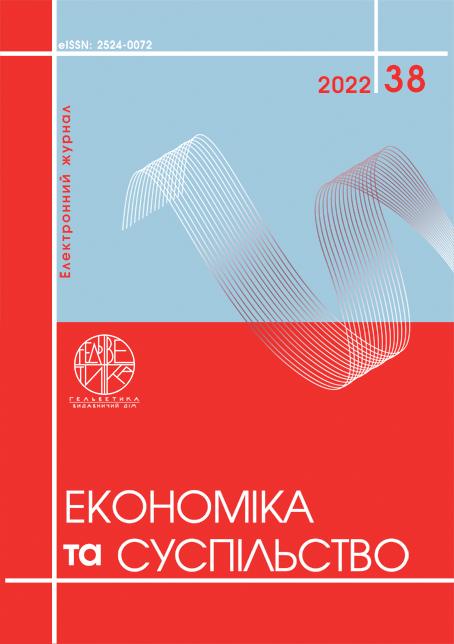ОСНОВНІ ЧИННИКИ КОВІДНОЇ ТА ВОЄННОЇ ІНФЛЯЦІЇ
Анотація
У статті розглянуто сучасний період помітного зростання темпів інфляції протягом двох останніх років. Досліджена динаміка загального рівня цін у розвинутих країнах, яка протиставляється епосі низької інфляції (2012–2019). Докладно проаналізовано еволюцію предмету наукових дискусій щодо інфляції з початку пандемії по мірі нагромадження практичного досвіду. Систематизовані основні чинники ковідної та воєнної інфляції як результат двох найбільших економічних травм ХХІ ст. Всі фактори упорядковані за впливом на сукупний попит та сукупну пропозицію. Попри значущість усіх наведених чинників, доведено домінування і в ковідній, і у воєнній інфляції детермінантів пропозиції, а саме кризи глобальних ланцюжків вартості. Але якщо інфляція часів пандемії була, передусім, «інфляцією чипів», то новий виток інфляції, що викликаний війною, має ширшу основу – подорожчання сировинних товарів, що свідчить про його довший ефект та глобальні наслідки.
Посилання
Baumann, P., Rossi, E. & Volkmann, A. (2021). What drives inflation and how? Evidence from additive mixed models selected by cAIC. SNB Working Papers, 12 (2021). URL: https://www.snb.ch/n/mmr/reference/working_paper_2021_12/source/working_paper_2021_12.n.pdfSuggested%20Citation
Blanchard, O. (2020). Is there deflation or inflation in our future? Vox.EU/ CEPR, Apr 24 (2020). URL: https://voxeu.org/article/there-deflation-or-inflation-our-future
Goodhart, Ch., Pradhan, M. (2020). Future imperfect after coronavirus. Vox.EU/ CEPR, Mar 27 (2020). URL: https://voxeu.org/article/future-imperfect-after-coronavirus
Higgins, M. (2021). Investors can temper their inflation fears: post-COVID inflation is unlikely to resemble the great inflation of 1968 to 1982. SSRN, Aug 15 (2021). DOI: http://dx.doi.org/10.2139/ssrn.3907668
Roubini N. (2021). The stagflation threat is real. Project Syndicate, Aug 30 (2021). URL: https://www.project-syndicate.org/commentary/mild-stagflation-is-here-and-could-persist-or-deepen-by-nouriel-roubini-2021-08?barrier=accesspaylog
Brunnermeier, M., Merkel S., Payne J. & Sannikov, Y. (2020). COVID-19: inflation and deflation pressures. Princeton University mimeo, Sep 15 (2020). URL: https://scholar.princeton.edu/sites/default/files/merkel/files/covid19inflationdisinflation.pdf
Baqaee, D., Farhi, E. (2022). Supply and demand in disaggregated Economic Review, 112, 5 (2022), 1397–1436. DOI: https://doi.org/10.1257/aer.20201229
Schacter, M. (2022). Inflation: low expectations set the stage for further surprise. The Financial Times, Apr 30 (2022). URL: https://www.ft.com/content/78d57446-0b7f-474c-998e-ccdff5ff81ea?desktop=true&segmentId=7c8f09b9-9b61-4fbb-9430-9208a9e233c8#myft:notification:daily-email:content
Cavallo, A. (2020). Inflation with COVID consumption baskets. NBER Working Paper Series, 27352, Jun (2020). DOI: https://doi.org/10.3386/w27352
Seiler, P. (2020). Weighting bias and inflation in the time of COVID-19: evidence from Swiss transaction data. Swiss Journal of Economics Statistics, 156, 13 (2020). DOI: https://doi.org/10.1186/s41937-020-00057-7
Binder, C. (2020). Coronavirus fears and macroeconomic expectations. Review of Economics and Statisetics, 102, 4 (2020), 721–730. DOI: https://doi.org/10.1162/rest_a_00931
Coibion, O., Gorodnichenko, Y. and Weber, M. (2020). Does policy communication during Covid‐19 work? SSRN Electronic Journal (2020), 1556–5068. DOI: https://doi.org/10. 3386/w27384
Candia, B., Coibion, O. & Gorodnichenko, Y. (2020). Communication and the beliefs of economic agents. SSRN Electronic Journal (2020), 1–48.
Basu K. (2022). Coordinating in the dark on inflation. Project Syndicate. Apr 29 (2022). URL: https://www.project-syndicate.org/commentary/global-monetary-policy-coordination-to-tackle-inflation-by-kaushik-basu-2022-04?barrier=accesspaylog
Moghadam R., Ranjit T. & Pelin B. (2014). Euro area – “deflation” versus “lowflation”. IMF Blog, Mar 4 (2014). URL: https://blogs.imf.org/2014/03/04/euro-area-deflation-versus-lowflation/
Kollmann, R. (2021). Effects of Covid-19 on Euro area GDP and inflation: demand vs. supply disturbances. International Economics and Economic Policy, 18 (2021), 475–492. DOI: https://doi.org/10.1007/s10368-021-00516-3
Guerrieri, V., Lorenzoni G., Straub L. & Werning I. (2022). Macroeconomic implications of COVID-19: can negative supply shocks cause demand shortages? American Economic Review, 112 (5) (2022), 1437–74. DOI: https://doi.org/10.1257/aer.20201063
Santacreu, A.M., LaBelle, J. (2022). Global supply chain disruptions and inflation during the COVID-19 pandemic. Federal Reserve Bank of St. Louis Review, Second Quarter (2022), 78–91. DOI: https://doi.org/10.20955/r.104.78-91
Leibovici, F., Dunn, J. (2021). Supply chain bottlenecks and inflation: the role of semiconductors. Federal Reserve Bank of St. Louis Economic Synopses, 28 (2021). DOI: https://doi.org/10.20955/es.2021.28
Pang I. (2021). China: PPI inflation has arrived and chip inflation is coming. ING. Think, May 11 (2021). URL: https://think.ing.com/snaps/china-ppi-inflation-has-arrived-and-chip-inflation-is-coming
Roubini N. (2021). Goldilocks is dying. Project Syndicate, Sep 21 (2021). URL: https://www.project-syndicate.org/commentary/reflation-trade-or-overheating-and-stagflation-by-nouriel-roubini-2021-09?barrier=accesspaylog


